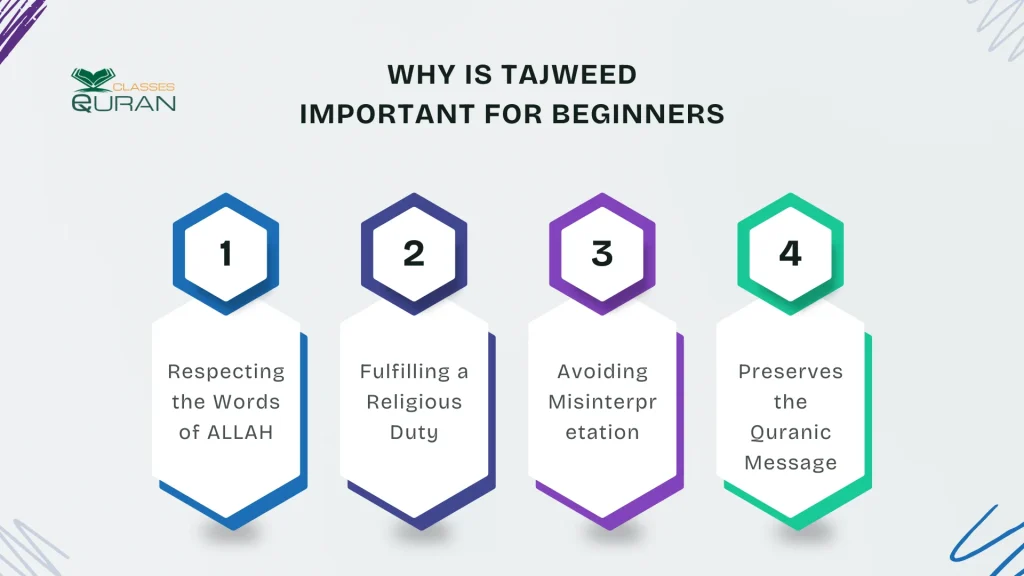What is Tajweed? Meaning, Rules, and Complete Guide to Quran Recitation
Welcome to your spiritual journey with eQuran Classes, where we unlock the beauty of Tajweed! Our certified instructors, with over 10 years of experience, blend classical scholarship with fresh teaching methods. This guide suits beginners, kids, new Muslims, and advanced tajweed learners, offering clear rules, real examples, and practical tips.

Recite the Quran with precision and heart—our academy’s mission! We draw from trusted sources like Imam Al-Jazari’s works and modern Islamic scholars. Start today, whether you’re just learning or refining your tajweed. Let’s dive into this sacred art together!
Reference: Imam Al-Jazari, Al-Muqaddimah fi’l-Tajweed (7th century), a cornerstone for Tajweed science.
What is Tajweed? Definition and Meaning
Tajweed comes from “j-w-d,” meaning to improve. It guides you to pronounce and articulate Quranic letters correctly, preserving Allah’s divine words. Master this skill to honor every verse!
History of Tajweed: From Revelation to Modern Practice
Tajweed began with the Prophet (PBUH) reciting orally. Scholars like Imam Al-Jazari later codified rules in the 7th century. Today, online classes bring this tradition to you!
Importance of Tajweed in Quran Recitation
Allah commands Tarteel in Surah Al-Muzzammil 73:4—recite with care! Tajweed prevents meaning shifts and earns you spiritual rewards. Make your recitation pure!
Reference: Tafsir Ibn Kathir, Surah Al-Muzzammil 73:4, highlights the obligation of measured recitation.
Benefits of Learning Tajweed
Tajweed boosts your spiritual growth and Salah quality. It inspires your community and even reduces stress. Embrace these gifts today!
Reference: Hadith in Sahih Bukhari (Book 61, Hadith 540), promises rewards for Quranic effort.
How to Learn Tajweed: Step-by-Step Guide for Beginners
Start with Arabic basics and Makharij to nail letter pronunciation. Join our online tajweed courses with certified tutors for expert guidance. Practice daily using recordings and prayers to build confidence. Explore apps and quizzes to track progress. Aim for Ijazah to master this sacred art!

Essential Tajweed Rules: Comprehensive Breakdown with Examples
1. Makharij Al-Huroof (Articulation Points of Letters)
Discover 17-29 articulation points across throat, tongue, lips, nasal passage, and oral cavity. Master “أقرأ” (Iqra) from Surah Al-Alaq to feel each sound’s origin!
2. Sifaat Al-Huroof (Characteristics of Letters)
Unlock the attributes shaping letter pronunciation. These 17 characteristics split into compulsory and temporary types, enhancing recitation beauty.
- Compulsory Characteristics: Vital for correct sounds—skip them, and the letter fails. Focus on these daily!
- Temporary Characteristics: Boost beauty but aren’t mandatory—omitting them softens the effect.
Controversial Characteristics (11 Types)
Five pairs of opposing traits shape letters—only one per letter applies. Practice these with care!
- Jahr (جهر) – Hams (همس)
- Jahr: Blast ع, ح with strong sound, stopping breath.
- Hams: Soften س, ص, letting breath flow (10 hidden, 19 prominent).
- Example: “حمد” (Hamd) roars; “سمع” (Samia) whispers.
- Shiddat (شدة) – Rakhawat (رخاوة)
- Shiddat: Hit ق, ط hard, halting voice (8 letters).
- Rakhawat: Ease ر, ز softly, voice flowing (16 letters).
- Example: “قلب” (Qalb) stands firm; “راح” (Raah) glides.
- Tawassut Moderation (توسط)
- Balance ج, ش—voice may stop or flow (5 letters like ت, د).
- Example: “جاء” (Jaa) flows with steady strength.
- Istila (استعلاء) – Istifal (استفال)
- Istila: Lift tongue for ص, ض toward palate (7 letters).
- Istifal: Keep tongue low for ر, ل (22 letters).
- Example: “صادق” (Saadiq) rises; “راحة” (Raaha) stays light.
- Itbaa (اطباع) – Infitah (انفتاح)
- Itbaa: Raise tongue middle for ق, ك (4 letters).
- Infitah: Keep it flat for ب, ت (25 letters).
- Example: “قرآن” (Quran) lifts; “بسم” (Bism) stays open.
Non-Controversial Characteristics (6 Types)
Unique traits add flair—master them for perfect recitation!
- Ismaat-Izlaaq (اسمات-زلق)
- Ismaat: Deepen ط, ظ with strong sound (23 letters).
- Izlaaq: Speed و, ي with quick lips/tongue (4 letters).
- Example: “طيب” (Tayyib) holds; “واضح” (Wadih) slips.
- Safeer (صفير)
- Hear a whistling sound in س, ص (4 letters).
- Example: “سمع” (Samia) sings with a whistle.
- Qalqalah (قلقلة)
- Feel a bounce in mute ق, ط, ب, ج, د.
- Example: “أقطع” (Aqta’) echoes with each stop.
- Leen (لين)
- Soften و, ي with tender sound, add Maddah if needed.
- Example: “يسر” (Yasir) flows gently.
- Tafshi (تفشي)
- Spread air in mouth, unique to ص.
- Example: “صوت” (Sawt) carries an airy touch.
- Istitala (استطالة)
- Stretch the sound, exclusive to ض.
- Example: “ضعيف” (Da’eef) lingers long.
- Inhiraf (انحراف)
- Shift tongue between ج and ش.
- Example: “جمع” (Jama’) vs. “شكر” (Shakr)—notice the tilt.
- Takrer (تكرير)
- Tremble ر with a repeated feel.
- Example: “رزق” (Rizq) quivers softly.
These characteristics shape every word’s beauty and correctness. Join our online classes to practice with a tutor and shine in recitation!
3. Noon Sakinah and Tanween Rules
Master Noon Sakinah and Tanween with four key rules! Izhaar clears the sound before throat letters, like in “منْ أحد” (4:171). Idgham merges with ي, ر, م, ل, و, ن—try “من يقول”. Iqlab shifts to Meem before ب, as in “منْ بعد”. Ikhfaa hides the sound nasally before ت, ث, like “أنْ تُؤْمِنُوا” (2:3). Practice these daily!
4. Meem Sakinah Rules
Perfect Meem Sakinah with three techniques! Ikhfaa Shafawi hides the sound before ب, like “همْ بِ”. Idghaam Shafawi blends with another Meem, as in “لَكُمْ مَا”. Izhaar Shafawi pronounces clearly before other letters. Start practicing now!
5. Noon and Meem Mushaddad
Add Ghunnah for 2 counts to Noon and Meem Mushaddad! Feel the nasal hum in “أمَّة” (2:143). This rule deepens your recitation—try it in prayers today!
6. Al-Madd (Elongation)
Explore Al-Madd’s stretch! Use two-beat for “قَالُوا” (2:11), flexible for 2-6 counts, four-beat after Sukoon, and six-beat for emphasis. Master these lengths with practice!
Reference: Tafsir Ibn Kathir, Surah Al-Baqarah 2:11, notes Madd’s rhythmic beauty.
7. Qalqalah (Echoing)
Feel the bounce in Qalqalah! Hit ق, ط, ب, ج, د with an echo when stopped, like “قلب”. Practice this lively sound to enrich your recitation!
Reference: Shaykh Muhammad Salih Al-Munajjid, IslamQA, explains Qalqalah’s vibrant effect.
8. Tarqeeq and Tafkheem (Thinning and Thickening)
Balance Tarqeeq and Tafkheem! Lighten Tarqeeq for some Raa, thicken Tafkheem for “رحمن” (heavy Raa). Switch these wisely to perfect your pronunciation!
Reference: Dr. Ayman Rushdi Suwayd, Tajweed Rules, 2004, guides on Raa rules.
9. Ghunnah (Nasalization)
Add Ghunnah’s 2-count hum to Noon and Meem! Hear it in “أنعمت” (1:7). This nasal touch elevates your recitation—practice it now!
10. Waqf and Ibtida (Stopping and Starting)
Learn Waqf and Ibtida pause rules! Use symbols like م (must stop) or لا (don’t stop) to guide your recitation flow. Master these breaks today!
Reference: Shaykh Yasir Qadhi, Tajweed Introduction, 2010, covers stop signs.
11. Al-Isti’aathah and Al-Basmalah
Start right with Al-Isti’aathah and Al-Basmalah! Seek refuge, then recite “بسم الله” to open every surah. Build this habit for spiritual strength!
Reference: Sahih Bukhari, Book 12, Hadith 738, affirms opening recitation rules.
12. Tajweed Symbols in the Quran
Spot Tajweed symbols! Red marks Madd, blue shows Ghunnah—use these color codes in Mushafs to guide your pronunciation. Study them now!
Reference: Quran.com, Tajweed Mushaf, offers visual aids for learners.
5 Common Tajweed Mistakes and How to Correct Them
Avoid these Tajweed slip-ups to perfect your recitation! Ignoring Makharij? Use a mirror to check tongue and lip positions. Missing Ghunnah? Listen to Qaris like Sheikh Al-Husary for that nasal hum. Overdoing or skipping Madd? Count beats carefully. Weak Qalqalah? Emphasize the bounce in ق, ط, ب, ج, د. Mixing Tafkheem and Tarqeeq? Study Sifaat traits daily. Fix these now!
| Mistake | Fix | Tip |
|---|---|---|
| Ignoring Makharij | Use a mirror | Watch tongue placement |
| No Ghunnah | Listen to Qaris | Mimic nasal hum |
| Over/Under Madd | Count beats | Time each stretch |
| Weak Qalqalah | Emphasize bounce | Feel the echo |
| Mixing Tafkheem/Tarqeeq | Study Sifaat traits | Compare heavy/light sounds |
Tajweed for Kids: Tips for Teaching Quran Recitation Skills
Make Tajweed fun for kids! Use colorful visuals and games to teach rules like Qalqalah’s bounce. Turn “قلب” into a bouncing ball activity—watch them learn with joy!
Balancing Quran Pronunciation and Melody for Perfect Recitation
Perfect your recitation by blending Tajweed with Maqamat melodies! Keep pronunciation sharp while adding soulful tunes, like in “الفatihة”. Practice this harmony daily!
Advanced Tajweed Topics
Take Tajweed further! Earn Ijazah for mastery, explore narration nuances like Hafs vs. Warsh, and integrate with Hifz. Join our advanced online courses now!
Reference: Imam Al-Jazari, Al-Muqaddimah fi’l-Tajweed, 7th century, details advanced paths.
Tajweed Quizzes and Practice Exercises
Test yourself! Quiz: Identify Jahr in “حمد”—listen for that strong, breath-stopping sound. Practice with “ح” and check your skills today!






